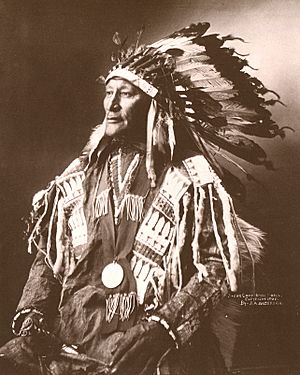Iron Shell facts for kids
Quick facts for kids
Iron Shell
|
|
|---|---|
| Tukiha Maza | |

Iron Shell (1900)
|
|
| Brulé Sioux leader | |
| Personal details | |
| Born | 1816 |
| Died | 1896 |
| Children | Hollow Horn Bear |
| Parent | Sicangu Chief Bull Tail |
Iron Shell (1816–1896) was an important chief of the Brulé Sioux people. He became well-known after a raid against the Pawnee in 1843. Later, he became a sub-chief of the Brulé, serving under Chief Little Thunder.
Iron Shell became the chief of the Brulé's Orphan Band during the Powder River War from 1866 to 1868. After conflicts with the United States, he signed the Fort Laramie Treaty in 1868. This treaty led him and his people to settle on the Great Sioux Reservation. He spent the rest of his life on what is now called the Rosebud Indian Reservation. Iron Shell's son was Hollow Horn Bear, who also became a famous leader.
Life of Iron Shell
Tukiha Maza, also known as Iron Shell, was born in 1816. His father was Chief Bull Tail of the Sicangu people. The name "Sicangu" means "burnt thighs." This name was given to some of the Lakota because their legs were burned in a prairie fire. The French later called them the Brulé.
Early Recognition
Iron Shell gained recognition for his bravery during a raid against the Pawnee in 1843. Thirteen years later, at Fort Pierre, he was made a sub-chief of the Brulé. He served under Chief Little Thunder.
Battle of Ash Hollow
In 1855, General William Harney and his 600 soldiers launched a surprise attack. This attack, known as the Battle of Ash Hollow, happened near present-day Lewellen, Nebraska. Chief Iron Shell fought against Harney's troops, who greatly outnumbered the Sioux warriors.
During this battle, two of Iron Shell's wives were captured, but he managed to escape. A total of 86 Sioux people were killed, including many women and children. This event was a terrible loss for the Sicangu people. They lost many lives and much property.
Later Years and Treaty
Iron Shell became the chief of the Brulé's Orphan Band during the Powder River War (1866-1868). He led many attacks against the Omaha and Pawnee tribes. On September 4, 1867, Chief Iron Shell and 180 of his followers arrived at North Platte.
He eventually signed the Fort Laramie Treaty of 1868. After signing, he and his people settled in the Upper Cut Meat District. This area was part of the Great Sioux Reservation, which was created by the treaty. The reservation was located in the West River area of what is now South Dakota.
In 1889, the United States government divided the Great Sioux Reservation. Iron Shell's area became part of the Rosebud Indian Reservation. He was buried near St. Francis, South Dakota.

